|
|---|
Friday, October 15, 2010
List of highest mountains and latest top-1
| It has been suggested that this article or section be merged with List of mountains by elevation. (Discuss) |

Mount Everest from the south, seen from an airplane. The peak rises over Lhotse (#4), while Nuptse is the ridge on the left.
The following is a list of the world's 100+ highest mountains per height above sea level (>7,200 metres / 23,622 feet), all of which are located in central and southern Asia. Only those summits are included that, by an objective measure, may be considered individual mountains as opposed to subsidiary peaks.
Bet you thought that the biggest mountain was Mount Everest! If you haven't already checked it out here at "Extreme Science", Mount Everest does hold a world record, but not as the biggest mountain. Everest is the highest elevation on land, but it is only a single peak in an entire mountain range. Mauna Loa is a single mountain on the island of Hawaii. The island of Hawaii is actually an island made up of five volcanoes which "blend" together because of their closeness to each other, making a single island.
Only about 13,448 ft/4100m of Mauna Loa are above sea level, so it may not seem like a very tall mountain. But, when you start measuring Mauna Loa from its true base on the bottom of the ocean, in the Hawaiian Trough, the total height exceeds that of Everest by over 3/4 of a mile. Mauna Loa is Hawaiian for "Long Mountain", probably because of its long, gently sloping shape. If you want to get really technical, Mauna Kea, a neighbor of Mauna Loa on the same island of Hawaii, is actually the tallest mountain in the world. Mauna Kea is about 350 ft/107m taller than Mauna Loa, but its mass doesn't compare to that of Mauna Loa. Mauna Loa takes up a lot of space because its mass is 9,700 cubic miles/40,000 cu km of mountain.
Mountain Born of Fire-
What makes Mauna Loa such a big mountain is the way it was formed. As part of the Hawaiian islands, Mauna Loa is a volcano, just like many others found on the island chain. The volcanoes in the Hawaiian islands are different from the cone-shaped, explosive, "fire breathing" dynamos that most of us think of when volcanoes come to mind. Mauna Loa is one of many shield volcanoes that make up the Hawaiian Islands. These are volcanoes that, compared to their more violent companions, erupt slowly and quietly. What really distinguishes a shield volcano is its shape - they are usually much wider than they are tall. Shield volcanoes are created when red hot lava oozes out from cracks, or fissures in the earth's crust.
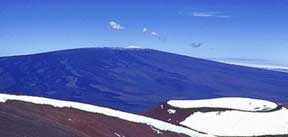 The biggest mountain in the world, Mauna Loa, is a shield volcano with gently sloping sides. |
In the case of the Hawaiian islands, the fissures were in the ocean floor. The lava cools as it comes in contact with the ocean water. The newly deposited lava raises the level of the ocean floor just in the area around the fissure.
Over time, and many oozing eruptions, a gently sloping sea mount forms. A sea mount is, quite simply, a mountain on the floor of the ocean, only the top doesn't reach above the surface. Over a million years, or more, lava slowly builds up the sea mount until the top reaches above the surface of the sea.
Considerations-

It is very unlikely that all given heights are correct to the nearest meter; indeed, the sea level is often problematic to define when a mountain is remote from the sea. Different sources often differ by many meters, and the heights given below may well differ from those elsewhere in this encyclopedia. As an extreme example, Ulugh Muztagh on the north Tibetan Plateau is often listed as 7,723 m (25,338 ft) to 7,754 m (25,440 ft), but appears to be only 6,973 m (22,877 ft) to 6,987 m (22,923 ft). Some mountains differ by > 100 m (330 ft) on different maps, while even very thorough current measurements of Mount Everest range from 8,840 m (29,003 ft) to 8,850 m (29,035 ft). These discrepancies serve to emphasize the uncertainties in the listed heights.
Images for largest mountain in the world-
Thank you for the feedback. Report another imagePlease report the offensive image. CancelDoneThough some parts of the world, especially the most mountainous parts, have never been thoroughly mapped, it is unlikely that any mountains this high have been overlooked, because synthetic aperture radar can and has been used to measure altitudes of most otherwise inaccessible places. Still, heights and/or prominences may be revised, so that the order of the list may change and even "new" mountains could enter the list over time. To be safe, the list has been extended to include all >7,200 m (23,622 ft) peaks.
The highest mountain is not necessarily the tallest, considering the difference in height between the peak and the surrounding base of the mountain. There is no precise definition of surrounding base, but Mount McKinley, Mount Kilimanjaro and Nanga Parbat are possible candidates for the tallest mountain on land by this measure. The bases of mountain islands are below sea level, and given this consideration Mauna Kea (4,207 m (13,802 ft) above sea level) is the world's tallest mountain and volcano, rising about 10,203 m (33,474 ft) from the Pacific Ocean floor. Ojos del Salado has the greatest rise on Earth— 13,420 m (44,029 ft) from the summit[citation needed] to the bottom of the Atacama Trench about 560 km (350 mi) away, though most of this rise is not part of the mountain.
Nor are they necessarily the largest. Mauna Loa (4,169 m (13,678 ft)) is the largest mountain on Earth in terms of base area (about 2,000 sq mi/5,200 km2) and volume (about 10,000 cu mi/42,000 km3), although, due to the intergrade of lava from Kilauea, Hualalai and Mauna Kea, the volume can only be estimated based on surface area and height of the edifice). Mt. Kilimanjaro is the largest non-shield volcano in terms of both base area (245 sq mi/635 km2) and volume (1,150 cu mi/4,793 km3). Mount Logan is the largest non-volcanic mountain in base area (120 sq mi/311 km2).
The highest mountains are not necessarily those farthest from the centre of the Earth, because the figure of the Earth is not spherical. Sea level closer to the equator is several miles farther from the centre of the Earth. The summit of Chimborazo, Ecuador's tallest mountain, is usually considered to be the farthest point from the Earth's centre, although the southern summit of Peru's tallest mountain, Huascarán, is another contender.
Geographical distribution-
Highest Mountain in the World
Mount Everest has some rivals!
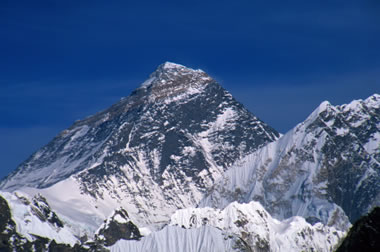 Mount Everest from Gokyo Ri. , ©iStockphoto.com by Grazyna Niedzieska |
Mount Everest:
The "Highest Altitude"
Almost everyone knows that Mount Everest is the highest mountain in the world and climbers from everywhere travel to Everest hoping to earn the distinction of climbing the "World's Highest".
The peak of Mount Everest is 8,848 meters (29,028 feet) above sea level. This high elevation gives Mount Everest the distinction of being the mountain with the highest altitude.
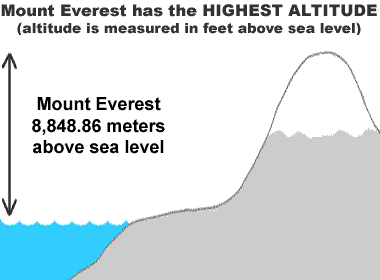
An altitude of 8,848 meters (29,028 feet) makes
Mount Everest Earth's highest mountain.
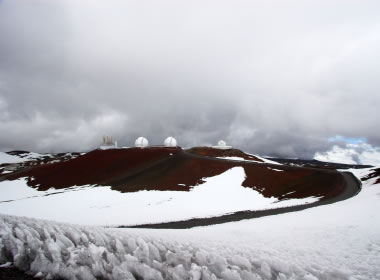 Mauna Kea - observatories in the Hawaiian snow © iStockphoto.com by Dan Schmitt |
Mauna Kea:
The "Tallest Mountain"
Mauna Kea has an altitude of 4,205 meters (13,796 feet) - much lower than Mount Everest. However, Mauna Kea is an island and if the distance from the bottom of the nearby ocean floor to the peak of the island is measured, then Mauna Kea is taller than Mount Everest.
Mauna Kea is over 10,000 meters tall compared to 8,848 meters for Mount Everest - making it the world's tallest mountain.
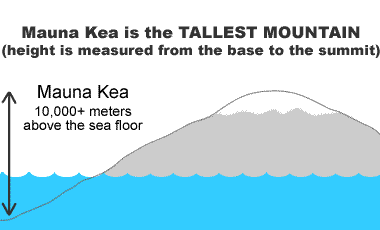
Mauna Kea rises over 10,000 meters above
the ocean floor making it taller than Everest.
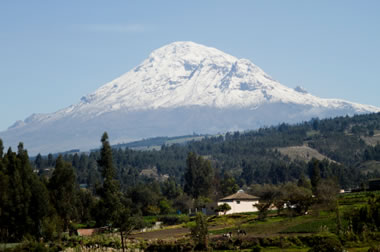 Chimborazo mountain in Ecuador © iStockphoto.com by Loic Bernard |
Chimborazo:
"Highest Above Earth's Center"
Chimborazo in Ecuador has an altitude of 6,310 meters (20,703 feet). Mount Everest has a higher altitude and Mauna Kea is "taller". However, Chimborazo has the distinction of being the highest mountain above Earth's center.
This is because Earth is not a sphere - it is an oblate spheroid. As an oblate spheroid, Earth is widest at it's equator. Chimborazo is just one degree south of Earth's equator and at that location it is 6,384 kilometers from Earth's center or about 2 kilometers farther from Earth's center than Mount Everest.
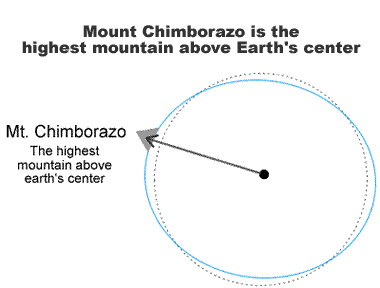
Chimborazo is located near the equator where earth's diameter is greatest.
Most mountains in the list are located in the Himalaya and Karakoram ranges. In fact, all 7,000 m (23,000 ft) peaks in the world are located in the centre of Asia (East Asia, Central Asia and South Asia) in a rectangle edged by Noshaq (7,492 m (24,580 ft)) on the Afghanistan-Pakistan border in the West, Peak Jengish Chokusu, (Tuōmù'ěr Fēng) (7,439 m (24,406 ft)) on the Kyrgyzstan - Xinjiang border to the North, Gongga Shan (Minya Konka) (7,556 m (24,790 ft)) in Sichuan to the East, and Kabru (7,412 m (24,318 ft)) on the Sikkim - Nepal border to the South.
The locations of the highest mountains are shown on the composite satellite image of High Asia below. The numbers refer to the ranking in the list. For clarity, lower peaks with labels overlapping higher peaks are left out of the main image. The boxed regions are those with the highest density of summits and are enlarged in two separate images to show all peaks.


Location of peaks in the Hindu Kush and Karakoram

Location of peaks in the Nepal Himalaya
The list-
Rank | Mountain | Height (m) | Height (ft) | Range | Coordinates | Prominence (m) | Parent mountain | First ascent | Ascents (attempts) |
|---|---|---|---|---|---|---|---|---|---|
| 1 | Mount Everest/ Sagarmatha / Chomolungma | 8,848 | 29,029 | Mahalangur Himalaya |  27°59′17″N 86°55′31″E / 27.98806°N 86.92528° / 27.98806; 86.92528 27°59′17″N 86°55′31″E / 27.98806°N 86.92528° / 27.98806; 86.92528 | 8,848 | none | 1953 | 145 (121) |
| 2 | K2/ Qogir/ Godwin Austen | 8,611 | 28,251 | Baltoro Karakoram |  35°52′57″N 76°30′48″E / 35.8825°N 76.51333°E / 35.8825; 76.51333 35°52′57″N 76°30′48″E / 35.8825°N 76.51333°E / 35.8825; 76.51333 | 4,017 | Mount Everest | 1954 | 45 (44) |
| 3 | Kangchenjunga | 8,586 | 28,169 | Kangchenjunga Himalaya |  27°42′09″N 88°08′49″E / 27.7025°N 88.14694°E / 27.7025; 88.14694 27°42′09″N 88°08′49″E / 27.7025°N 88.14694°E / 27.7025; 88.14694 | 3,922 | Mount Everest | 1955 | 38 (24) |
| 4 | Lhotse | 8,516 | 27,940 | Mahalangur Himalaya |  27°57′42″N 86°55′59″E / 27.96167°N 86.93306°E / 27.96167; 86.93306 27°57′42″N 86°55′59″E / 27.96167°N 86.93306°E / 27.96167; 86.93306 | 610 | Mount Everest | 1956 | 26 (26) |
| 5 | Makalu | 8,485 | 27,838 | Mahalangur Himalaya |  27°53′21″N 87°05′19″E / 27.88917°N 87.08861°E / 27.88917; 87.08861 27°53′21″N 87°05′19″E / 27.88917°N 87.08861°E / 27.88917; 87.08861 | 2,386 | Mount Everest (Lhotse) | 1955 | 45 (52) |
| 6 | Cho Oyu | 8,201 | 26,864 | Mahalangur Himalaya |  28°05′39″N 86°39′39″E / 28.09417°N 86.66083°E / 28.09417; 86.66083 28°05′39″N 86°39′39″E / 28.09417°N 86.66083°E / 28.09417; 86.66083 | 2,340 | Mount Everest | 1954 | 79 (28) |
| 7 | Dhaulagiri I | 8,167 | 26,795 | Dhaulagiri Himalaya |  28°41′45″N 83°29′36″E / 28.69583°N 83.49333°E / 28.69583; 83.49333 28°41′45″N 83°29′36″E / 28.69583°N 83.49333°E / 28.69583; 83.49333 | 3,357 | K2 | 1960 | 51 (39) |
| 8 | Manaslu | 8,163 | 26,781 | Manaslu Himalaya |  28°32′58″N 84°33′39″E / 28.54944°N 84.56083°E / 28.54944; 84.56083 28°32′58″N 84°33′39″E / 28.54944°N 84.56083°E / 28.54944; 84.56083 | 3,092 | Cho Oyu | 1956 | 49 (45) |
| 9 | Nanga Parbat | 8,126 | 26,660 | Nanga Parbat Himalaya |  35°14′18″N 74°35′22″E / 35.23833°N 74.58944°E / 35.23833; 74.58944 35°14′18″N 74°35′22″E / 35.23833°N 74.58944°E / 35.23833; 74.58944 | 4,608 | Dhaulagiri | 1953 | 52 (67) |
| 10 | Annapurna I | 8,091 | 26,545 | Annapurna Himalaya |  28°35′43″N 83°49′11″E / 28.59528°N 83.81972°E / 28.59528; 83.81972 28°35′43″N 83°49′11″E / 28.59528°N 83.81972°E / 28.59528; 83.81972 | 2,984 | Cho Oyu | 1950 | 36 (47) |
Stem and leaf plot-The following is a stem and leaf plot of the above data. The two digits to the left of the line are the first two digits of the mountain's height, and each digit to the right of the line represents the third digit of the mountain's height. Each number on the right is linked to the corresponding mountain's article. For example, the height of one of the mountains (namely Mount Everest) is 884x meters. Also, it is apparent that there are only 5 mountains above 8,200 meters.Everest is the highest elevation on land, but it is only a single peak in an ... The biggest mountain in the world, Mauna Loa, is a shield volcano What is the longest river in the world? Smallest country? Biggest cities? Check out our list of highest mountains or deepest spots in the ocean. From Wikipedia-The largest mountain in the world always give new think to us. |
0 Comments:
Subscribe to:
Post Comments (Atom)




.jpg)










